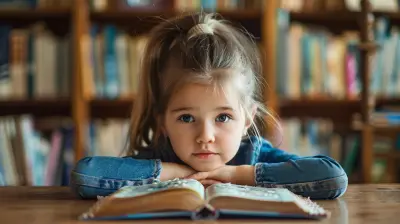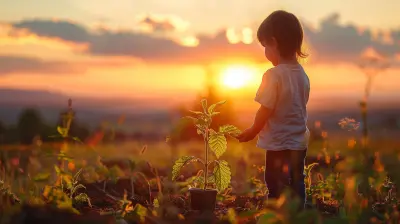Gratitude Activities That Will Inspire Your Kids All Year Round
15 November 2025
Parenting is a wild ride, isn’t it? Between the school drop-offs, endless snacks, and bedtime negotiations, it’s easy to get caught up in the chaos. But amidst all the craziness, there’s one tiny but mighty habit that can genuinely change the way your kids see the world: gratitude.
Yep, that simple “thank you” goes deeper than good manners. Teaching your kids to appreciate what they have (instead of always wanting more) can shape them into compassionate, thoughtful, and resilient humans. And the best part? Gratitude can be fun, not forced.
If you’ve been wondering how to sprinkle some thankfulness into your family's daily routine without making it feel like a chore, you’re in the right place. Below, we’re diving deep into a year-round collection of gratitude activities that will inspire your kids—and maybe even you, too!
Why Teaching Gratitude Matters
Before we dive into the actual activities, let’s get real for a sec—why does gratitude even matter?Well, studies show that kids who regularly practice gratitude tend to be happier, sleep better, have stronger relationships, and bounce back from tough times more easily. It’s like giving their little hearts armor, made out of kindness and awareness.
Gratitude isn’t just saying “thanks” when someone hands them a cookie. It’s a way of noticing the good—whether it’s their favorite toy, a hug from grandma, or catching fireflies on summer nights. And when they get used to paying attention to those moments, life starts feeling more magical.
1. Start a Gratitude Jar
Let’s kick things off with a classic: the gratitude jar.How it Works:
Grab a mason jar (or any container you’ve got lying around), some colorful paper, and pens. Every day or week, ask your kids to write down something they’re thankful for, fold it up, and drop it in the jar. It can be big (“I’m thankful for my dog”) or silly (“I’m grateful for waffles that don’t burn”).Why It Rocks:
It turns gratitude into a tangible habit. Plus, when they’re having a rough day, you can read the notes out loud and remind them of life’s little joys.Pro Tip: Decorate the jar together to get them excited. Stickers, glitter, googly eyes—the more over-the-top, the better.
2. Gratitude Walks
Ever tried a gratitude walk? It’s like a scenic stroll, but with an attitude of thankfulness.What To Do:
Take a walk with your kids and challenge them to point out things they’re grateful for along the way. A blooming flower, a cool-looking rock, a neighbor’s cute dog—nothing is too small. You can even make it a game: who can spot the most “thankful things”?The Benefits:
Walking gives them time to reflect without the pressure of sitting still. Plus, the fresh air works wonders for everyone's mood.
3. Thank-You Notes With a Twist
Sure, thank-you cards are nice after birthdays. But what if they weren’t just for gifts?Try This:
Help your kids write thank-you notes to people they see every day but might not think to appreciate—a school crossing guard, the mail carrier, the janitor at school. These small acts teach your kids to value kindness in all its forms.Creative Angle:
Let them design their own cards with drawings, stickers, or even poems. It becomes more than an assignment—it becomes art with heart.4. Gratitude Drawing Time
Sometimes kids express themselves better with crayons than words. That’s where gratitude drawing comes in.How It Works:
Grab the art supplies and ask your kids to draw something or someone they’re grateful for. It could be their best friend, their pet cat, or even their favorite ice cream flavor.Why It’s Great:
It taps into their natural creativity while encouraging mindfulness. Plus, displaying their drawings on the fridge or wall reminds them daily of what they love.5. “Highs and Lows” Dinner Table Talk
If your dinner table conversations are stuck in the “how was your day?” rut, this one’s for you.Game Plan:
Go around the table and share one high (best part of your day) and one low (tough part). Then, add a “gratitude moment”—something you appreciated that day, even if everything felt off.Why It Helps:
It teaches your kids to find something good, even when the day didn’t go as planned. That mindset? Priceless.6. Gratitude Bingo
Yes, bingo—but make it thankful.How To Play:
Create a bingo sheet with different gratitude prompts like:- Thankful for a friend
- Thankful for nature
- Thankful for something funny
- Thankful for a favorite song
Every time they complete one, they mark it off. You can offer small rewards or just celebrate finishing the whole board.
Fun Twist:
Make it seasonal—think pumpkin-themed in the fall or sunshine-inspired in the summer.7. Kindness Chain Reaction
Gratitude and kindness go hand in hand, right?Activity Idea:
Start a kindness chain where each act of appreciation leads to another. For example, your child thanks their teacher, then that teacher thanks a colleague, and so on. Keep track and see how far the ripple effect spreads.Good To Know:
This teaches kids that their actions matter in a big way. One tiny thank-you can start a wave of positivity.8. Gratitude Story Time
Whether your kids are into princesses, pirates, or planets, there’s always room for gratitude in story time.What You Can Do:
Pick books that focus on thankfulness or have characters who show appreciation. After reading, ask your child how they think those characters felt and how gratitude played a part.Book Bonus:
Let your child create their own gratitude story with homemade books, comic strips, or paper puppets. Their imagination has no limits!9. Photo Gratitude Journal
Kids love taking photos (and let’s be honest, you probably have 8,000 of them on your phone already).How It Works:
Let them snap a daily or weekly photo of something they’re grateful for. Print them out and put them in a “Gratitude Album.”Why It Clicks:
It modernizes the gratitude journal in a way kids totally get. And down the line? It makes an amazing keepsake.10. Create a Gratitude Calendar
Instead of just counting down to holidays and birthdays, how about counting up the good stuff?How To Do It:
Design a monthly calendar where each day your child writes or draws one thing they’re thankful for. You can hang it in their room or in your kitchen for everyone to see.Bonus Benefit:
This makes gratitude a part of daily life, not a once-in-a-while thing.11. Favorite Things Show and Tell
Remember show-and-tell from kindergarten? Let’s bring it back—with a "thankful twist."Setup:
Each week, have a mini show-and-tell session where your child picks one thing they’re grateful for and explains why. It could be a toy, a photo, or something abstract like “quiet time.”Parent Tip:
Join in yourself! When kids see adults expressing gratitude, they’re much more likely to internalize it.12. Volunteer as a Family
Ready to take things up a notch? Roll up your sleeves and show your kids what gratitude looks like in action.What You Can Do:
Find a local food bank, animal shelter, or charity event where kids can help out (age-appropriate, of course). Talk afterward about how giving your time is a way to say "thank you" for what you have.What They'll Learn:
Empathy. Perspective. Compassion. All the big stuff that sticks with them for life.Keeping Gratitude Going All Year Long
Let’s be real—keeping habits alive for a whole year is tough. (We’ve all started a journal that lasted three days, right?) But the key here isn’t perfection—it’s consistency.Here’s how you can keep the gratitude spirit thriving:
- Make it part of your routine. Tie it to something regular like bedtime or dinner.
- Lead by example. Kids mimic what they see. Show appreciation and they’ll follow your lead.
- Check in. Ask them how their favorite gratitude activity is going. Switch things up if needed.
Above all, keep it light and fun. Gratitude isn’t homework—it’s heart work.
Final Thoughts
Gratitude isn’t just a seasonal thing—it’s a life lesson. And when you make it playful and real, your kids won’t roll their eyes or groan. They’ll actually start looking for the bright spots in every day.Whether it’s a jar full of thankful notes, a sidewalk covered in chalk appreciation, or a calendar filled with doodled happiness, these activities help your kids create a positive habit that lasts. And before you know it, you’ll catch them saying “thank you” for the tiniest of moments—and meaning it.
So here's to raising thankful humans, one giggle-filled activity at a time.
all images in this post were generated using AI tools
Category:
Teaching GratitudeAuthor:

Max Shaffer

